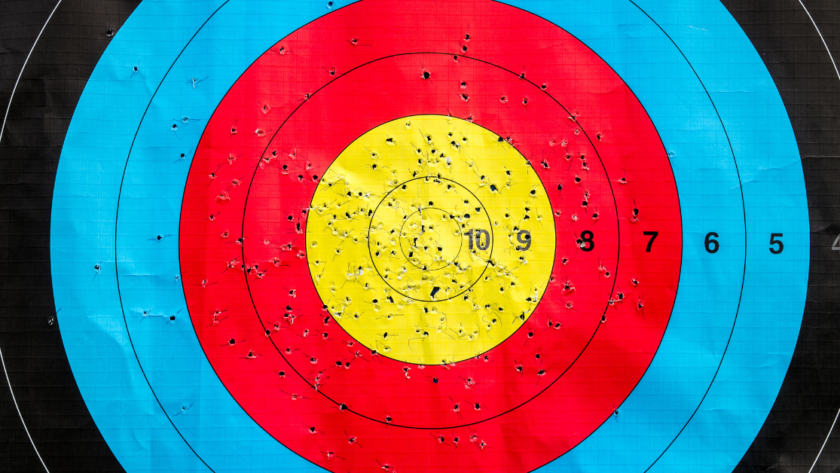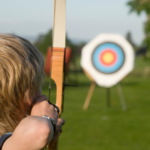Archery combines precision, focus, and skill into a captivating sport that has enthralled enthusiasts for centuries.
Whether you’re just starting out or you’ve been shooting arrows for years, understanding archery scoring is crucial for tracking your progress and competing effectively.
In this guide we’ll explore the fascinating world of archery scoring, covering everything from the fundamentals to advanced techniques that will help elevate your game.
The Fundamentals of Archery Scoring
Archery scoring forms the backbone of competitive archery, providing a standardized method to measure an archer’s accuracy and consistency. The basic principle is straightforward: arrows are assigned point values based on where they land on a target face.
However, the specifics can vary depending on the type of archery, the governing body, and the particular competition.
Target Faces and Scoring Rings
The most common target face in modern archery is the World Archery (formerly FITA) target. This circular target is divided into ten concentric rings, each assigned a point value from 1 to 10.
The innermost ring, known as the X-ring or inner ten, is the smallest and most challenging to hit consistently.
The scoring rings are typically colored as follows:
- 10 and X: Yellow
- 8 and 9: Red
- 6 and 7: Blue
- 4 and 5: Black
- 2 and 3: White
- 1: White (outermost ring)
In outdoor target archery, the size of the target face varies depending on the distance being shot. For example, a 122cm target face is used for longer distances (70m, 60m, 50m), while a smaller 80cm face is used for shorter distances (30m, 25m).
Scoring Systems
Several scoring systems are used in archery, each with it’s own nuances and applications. Let’s explore some of the most common ones:
World Archery Scoring (Metric)
This is the standard scoring system used in international competitions and the Olympics. In this system:
- The X-ring counts as 10 points
- Rings are scored from 10 to 1
- A perfect score for a full FITA round (144 arrows) is 1440 points
Imperial Scoring
Used primarily in the United Kingdom, this system assigns different point values to the rings:
- Gold (inner): 9 points
- Gold (outer): 7 points
- Red (inner): 5 points
- Red (outer): 3 points
- Blue (inner): 1 point
- Blue (outer) and beyond: 0 points
NFAA Indoor Round Scoring
The National Field Archery Association (NFAA) uses a different target face for indoor competitions, with five concentric rings:
- Center ring: 5 points
- Next ring: 4 points
- Outer rings: 3, 2, and 1 point respectively
3D Archery Scoring
In 3D archery, where archers shoot at three-dimensional animal-shaped targets, scoring is typically based on hit zones:
- Inner kill zone: 11 or 12 points
- Vital zone: 10 points
- Body: 8 points
- Leg or hoof: 5 points
Scoring Etiquette and Procedures
Proper scoring etiquette is crucial in archery competitions to ensure fairness and accuracy. Here are some key points to remember:
Arrow Calling
The archer whose arrows are closest to the center typically calls the scores for all arrows in the target. This responsibility rotates among the group members to maintain fairness and prevent bias.
Verification
Other archers in the group should verify the called scores before arrows are removed from the target. This double-checking process helps catch any potential errors or discrepancies.
No Touching
Arrows should not be touched or removed from the target until all arrows have been scored and recorded. This rule prevents accidental movement of arrows that could affect their scoring position.
Line Cutters
If an arrow touches the line between two scoring zones, it’s awarded the higher score. This rule can be crucial in close competitions, where every point matters.
Bounce-Outs and Pass-Throughs
Special rules apply for arrows that bounce out of the target or pass completely through it. Generally, if the impact point can be identified, the arrow is scored accordingly.
If the impact point cannot be determined, the arrow may be re-shot or given the lowest unmarked score, depending on the competition rules.
Scoring Errors
Any disputes or errors should be resolved immediately, preferably before arrows are removed from the target. If a disagreement cannot be resolved among the group, a judge or tournament official should be called to make a ruling.
Advanced Scoring Concepts
As you progress in archery, you’ll encounter more advanced scoring concepts that can impact your competitive performance and overall archery experience.
X-Count and Tie-Breakers
In many competitions, the X-ring (inner ten) is used as a tie-breaker. While it counts as 10 points like the rest of the yellow ring, the number of Xs an archer scores is recorded separately.
In the event of a tie in total points, the archer with the higher X-count wins.
This system adds an extra layer of precision to scoring, rewarding archers who can consistently hit the smallest part of the target. It also provides a clear method for breaking ties without requiring extra shooting.
Cumulative Scoring and Handicap Systems
Many archery organizations use added scoring systems to track an archer’s progress over time. These systems often incorporate handicaps, which allow archers of different skill levels to compete on a more level playing field.
For example, the Archery GB handicap system assigns a handicap number to each archer based on their average scores.
This handicap can then be used to calculate a “handicap adjusted score” for competitions, giving less experienced archers a fair chance against more seasoned competitors.
Cumulative scoring systems serve several purposes:
- They provide a long-term view of an archer’s performance, smoothing out day-to-day variations.
- They allow for meaningful comparison between archers who may not compete directly against each other.
- They encourage consistent participation and improvement over time.
Classification Systems
Classification systems, such as the Archery GB classification scheme, categorize archers based on their skill level. These classifications (e.g., Third Class, Second Class, First Class, Bowman, Master Bowman, Grand Master Bowman) are determined by an archer’s scores in recognized rounds.
These systems serve many purposes:
- They provide archers with clear goals for improvement
- They allow for fairer grouping in competitions
- They offer a sense of achievement and progression in the sport
To advance through the classifications, archers must consistently achieve certain score thresholds in official competitions. This encourages regular participation and gives archers tangible milestones to work towards.
Electronic Scoring Systems
As technology advances, electronic scoring systems are becoming more prevalent in archery. These systems use cameras or sensors to detect arrow impacts and automatically calculate scores.
While not yet universally adopted, electronic scoring offers several advantages:
- Increased accuracy and reduced human error
- Faster scoring process, especially for large tournaments
- Real-time score updates for spectators and archers
- Easier data collection for statistical analysis
However, electronic systems also present challenges, such as the need for reliable power sources and the potential for technical malfunctions.
As these systems continue to evolve, they’re likely to become more common in high-level competitions and may eventually trickle down to local and club-level events.
Strategies for Improving Your Archery Score
Understanding scoring is just the first step. To truly excel in archery, you need to develop strategies that maximize your point potential.
Here are some tips to help you improve your scores:
Focus on Consistency
Aim for tight arrow groupings as opposed to trying to hit the X every time. Consistent 9s and 10s will yield a better score than a mix of Xs and 7s.
This approach also helps build confidence and reduces the pressure of trying to make every shot perfect.
Practice at Varying Distances
This helps you develop a better understanding of how distance affects your aim and arrow flight. It also prepares you for different competition formats and improves your overall versatility as an archer.
Mental Preparation
Develop routines and mental strategies to maintain focus and manage pressure during scoring rounds. This might include visualization techniques, breathing exercises, or positive self-talk.
The mental aspect of archery becomes increasingly important as you advance in skill level.
Analyze Your Scores
Keep detailed records of your practice and competition scores. Look for patterns to identify areas for improvement.
This data-driven approach can help you make targeted adjustments to your technique or equipment.
Equipment Tuning
Ensure your bow is properly tuned and your arrows are matched to your setup. Even small equipment issues can significantly impact your scores.
Regular maintenance and periodic professional tuning can make a big difference in your performance.
Study Wind and Weather Effects
For outdoor archery, understanding how wind and weather conditions affect your arrows can help you make better aiming decisions.
Practice in various conditions and learn to read the wind using flags, grass movement, or other indicators.
Practice Under Pressure
Set up mock competitions or join in local tournaments to get used to the pressure of scored rounds. The more comfortable you become with competitive situations, the better you’ll perform when it really counts.
Advanced Techniques for Maximizing Your Score
Now that we’ve covered the basics and some intermediate strategies, let’s explore some advanced techniques that can help you squeeze out those extra points and elevate your archery game to the next level.
Precision Aiming Techniques
One of the most critical aspects of high-level archery is developing a precise and consistent aiming technique. Here are some advanced methods to consider:
Floating Anchor
Instead of using a fixed anchor point, some top archers use a floating anchor technique. This involves slightly adjusting your anchor point based on the distance and wind conditions, allowing for more precise aiming.
While this technique needs extensive practice to master, it can provide greater flexibility and accuracy in varying shooting conditions.
Micro-Adjustments
Learn to make tiny adjustments to your aim during the shot process. This can involve minute changes in your body position or slight shifts in your sight picture.
These micro-adjustments allow you to fine-tune your aim based on feedback from your body and the environment, potentially leading to more accurate shots.
Sight Picture Visualization
Develop a clear mental image of your perfect sight picture. Practice visualizing this image before and during your shot sequence to improve consistency.
This technique helps train your brain to recognize and copy the ideal alignment of your sight, target, and arrow.
Advanced Shot Execution
Refining your shot execution can lead to significant improvements in your scores. Consider these advanced techniques:
Back Tension Release
For compound archers, mastering a back tension release aid can lead to a smoother, more consistent release and potentially higher scores.
This technique involves using the muscles of your back to trigger the release, as opposed to your fingers, reducing the chance of torqueing the bow during the shot.
Clicker Control
For recurve archers, developing precise control over your clicker can improve shot timing and consistency. The clicker is a small device that makes a clicking sound when the arrow is drawn to the fix length.
Achieving Proficiency at the clicker involves developing a smooth, consistent draw and release that works in harmony with this timing device.
Follow-through Analysis
Pay close attention to your follow-through after each shot. A consistent follow-through often shows a well-executed shot.
Analyze your follow-through to identify any inconsistencies or issues in your form that may be affecting your accuracy.
Mental Game Mastery
At the highest levels of archery, the mental game becomes increasingly important. Here are some advanced mental techniques to incorporate:
Visualization
Spend time visualizing perfect shots and successful competitions. This mental rehearsal can improve your actual performance by training your brain to recognize and copy successful patterns.
Visualization can be particularly effective when combined with physical practice.
Pressure Management
Develop strategies for managing pressure during high-stakes situations. This might include breathing exercises, positive self-talk, or pre-shot routines.
Learning to perform under pressure can make a significant difference in competitive situations.
Flow State Induction
Learn to induce a “flow state” or “being in the zone” during competition. This often involves finding the right balance between challenge and skill level.
When in a flow state, archers often report feeling fully immersed in the task, with a sense of efficient control and peak performance.
Advanced Score Analysis
To continue improving, you need to analyze your performance in detail. Here are some advanced analysis techniques:
Shot Mapping
Create detailed maps of your arrow placements over many rounds. This can help identify any consistent biases in your shooting.
For example, you might notice that you tend to hit slightly left of center under certain conditions, allowing you to make suitable adjustments.
Statistical Analysis
Use statistical tools to analyze your scores over time. Look for trends, correlations, and areas of inconsistency.
This data-driven approach can reveal patterns that might not be obvious from casual observation, helping you make more informed decisions about your training and equipment.
Video Analysis
Record your shooting sessions and analyze your form and technique frame by frame. This can help you identify subtle issues that might be affecting your scores.
Pay particular attention to your release, follow-through, and overall body position throughout the shot sequence.
Equipment Optimization
At the advanced level, every small detail of your equipment setup can make a difference. Consider these advanced equipment optimization techniques:
Arrow Spine Matching
Ensure your arrows are perfectly matched to your bow’s draw weight and your draw length. Even small mismatches can affect accuracy at long distances.
Consider working with a professional arrow builder to create a set of arrows precisely tuned to your setup and shooting style.
Stabilizer Tuning
Experiment with different stabilizer configurations to find the perfect balance for your shooting style. This might involve adjusting the length, weight, and positioning of your front and side stabilizers.
The goal is to find a setup that provides most stability while still feeling comfortable and natural.
Sight Optimization
For compound archers, consider using a lens in your sight and experiment with different magnifications to find what works best for you. Some archers prefer a higher magnification for increased precision, while others find that a lower magnification provides a clearer overall picture of the target.
Frequently Asked Questions
What is the highest score in archery?
The highest possible score in a standard World Archery round (72 arrows) is 720 points. This would need hitting the 10-ring with every single arrow.
How is archery scored in the Olympics?
Olympic archery uses the World Archery scoring system. Archers shoot at a 122cm target face from 70 meters.
The target has 10 scoring zones, with the innermost gold ring (10 points) measuring just 12.2cm in diameter.
What does X mean in archery scoring?
In archery, ‘X’ refers to the innermost ring of the 10-point scoring zone. While it counts as 10 points, the number of X’s is often used as a tiebreaker in competitions.
How do you read archery scores?
Archery scores are typically read from highest to lowest. For example, if an archer shoots six arrows and hits 10, 9, 9, 8, 7, 7, it would be read as “54 points, 10-9-9-8-7-7.”
What is a good archery score for a beginner?
For a beginner shooting at a standard 40cm target face from 18 meters, consistently scoring 200-250 out of 300 (30 arrows) is considered good progress.
How is 3D archery scored?
3D archery typically uses a different scoring system than target archery. Most 3D targets have three scoring zones: 10 points for the inner vital zone, 8 points for the outer vital zone, and 5 points for a hit anywhere else on the target.
What is the difference between FITA and World Archery scoring?
FITA (Fédération Internationale de Tir à l’Arc) was the former name of World Archery. The scoring system stays the same – it’s just a change in organizational name.
How do archery handicaps work?
Archery handicaps are a way to level the playing field between archers of different skill levels. They’re calculated based on an archer’s average scores and can be used to adjust scores in handicap tournaments.
What is a perfect score in NFAA indoor archery?
In a standard NFAA indoor round (60 arrows), a perfect score would be 300 points, with all arrows hitting the 5-point center ring.
How are line-cutter arrows scored in archery?
In archery, if an arrow touches the line between two scoring zones, it’s awarded the higher score. This is known as a “line-cutter” and can make a significant difference in close competitions.
Key Takeaways
- Archery scoring systems vary depending on the type of archery and governing body, but all aim to measure accuracy and consistency.
- Understanding scoring rings, point values, and special rules (like line cutters) is crucial for accurate scoring.
- Advanced concepts like X-counts, handicap systems, and classifications add depth to competitive archery.
- Electronic scoring systems are changing the landscape of archery competitions.
- Improving your archery score needs a combination of technical skill, mental preparation, and strategic thinking.
- Advanced techniques in aiming, shot execution, mental game, score analysis, and equipment optimization can help take your archery to the next level.



